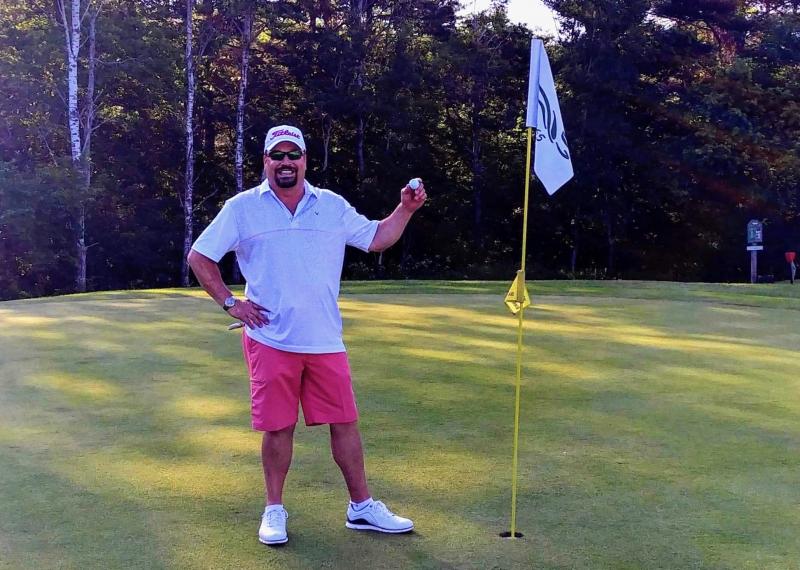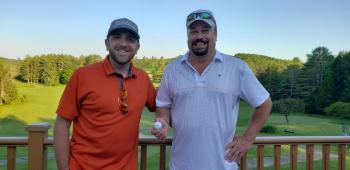ROCKPORT – It’s called an albatross, and that is when you make a hole-in-one on a par four hole on a golf course. John McCafferty, of Searsmont, did just that July 8 at the Goose River Golf Club, on Park Street in Rockport.
Alex Plummer, head golf professional at Goose River, was amazed.
“I’m jealous because I’ve never had one,” he said. “It’s impressive and I was happy to hear about it. He’s a great guy and I’m thankful he played our course. I’m going to give him a complimentary membership for the rest of the year so he can play here as much as he wants to.”
This was the first-ever hole-in-one for McCafferty.
“We got the hole-in-one on the Number Six hole, which is a par four,” said McCafferty. “It feels great. Especially since it’s such a nice golf course and the people were good about it here. They made me feel special.”
Par is the number of strokes a golfer is expected to need to get to any given hole on the course. The par is assigned based on the number of yards the putting green is from the tee.
An albatross can also be called a double-eagle in golf parlance. Double-eagle is more commonly used in the U.S. and albatross more in Europe, but the two are synonymous and mean the same thing.
You can score an albatross by making a hole-in-one on a par four hole, or by scoring a two on a par five-hole.
According to the Professional Golf Association (PGA), the odds of an average golfer making a hole-in-one are 12,000 to 1. Visit the website for a boatload of other facts about holes-in-one.
McCafferty said never in his wildest dreams did he ever think he would get a hole-in-one.
“I thought if I ever did get a hole-in-one it would be on a par three,” he said. “I prayed that would happen and that there was a witness there because if there’s not a witness, it didn’t happen.”
Luckily there was a witness.
Nate Tolman, of Rockport, was playing behind McCafferty and got to see him hit the ball. At that point, McCafferty decided to let Tolman play through.
“A gentleman was playing behind me and I let him play by and he got to see me hit the ball,” McCafferty said.
McCafferty said Tolman went down to the green and the ball was in the hole.
“We saw it go in that direction,” he said, “but the sun was in the way and we didn’t actually see it roll in, but I knew what ball I had. When he got down to the hole he put in and my ball was in there. He came back and asked me what my ball was to double-check and make sure. I told him what my ball was and he said you got it right in the hole.”
McCafferty said he and Tolman played out the last three holes together.
“It was a pleasure to play out the last three holes with him,” he said. “We really had a good conversation and it was fun to play out the round with him.”
Tolman, who has been playing golf his whole life, beginning with junior golf at age 8, at Goose River, said: “I was surprised when I finished the hole and found two balls, only expecting to see one. I figured at that point it was either a joke or he played a hole in one. I went back to him and asked what his ball was, and when he told me, it was a great moment.”
Tolman said he has been trying his whole life to get a hole-in-one.
“Hopefully I can pull it off someday,” he said. “It was nice to see a fellow golfer get it done.”
McCafferty has only been playing golf since last summer and said it was sheer luck. But there is a reason McCafferty started playing golf.
In 1979, McCafferty was the sole survivor of the worst plane crash in Maine’s history. Seventeen of the 18 people aboard the DeHavilland Otter crashed in heavy fog on Owls Head as the plane attempted to land at what is now Knox County Regional Airport.
“I started playing golf because I missed sports,” McCafferty said. “I’m limited to what I can do because of past injuries. Within a matter of weeks, I noticed that I was having fewer nightmares about the plane crash, so I told my fiancé that I thought the golf was helping my post-traumatic stress syndrome (PTS).”
Then, they learned, by watching the golf channel, that a number of veterans are using golf to deal with their PTS.
“A lot of them were saying it works great,” said McCafferty. “That convinced me and now golf is going to be a part of my life as long as I can swing a club.”
McCafferty said it doesn't matter to him how good he is. As long as he can be out on a course and having fun he will be a happy man.
And he likes Goose River.
“It’s a good and challenging course,” he said. “You don’t need somebody to go out with. You can play by yourself which I do a lot. You have some beautiful views around the greens and tee boxes. There are mountain views and a variety of greens to play on that offer you a variety of shots to change up your game and all the people I have met here have been just great.”
McCafferty was 16 when he survived the plane crash. Finally feeling some peace over the event he has decided to write a book about it.
A pipefitter by trade and now retired, McCafferty took writing lessons at the Belfast Area High School.
“A professor who was helping me passed away,” he said. “I put out a plea on the 40th anniversary of the plane crash, which was May 30, of this year. I put out a plea that anybody who could help me with the book could reach me at johnmccaffertysolesurvivor@gmail.com and any suggestion or help they could provide in the completion of this book, I would be glad to hear it.”
McCafferty said the book is about 60-percent complete.
“It can be hard to write about it sometimes, but it’s not hard to recall,” he said. “I’m past the crash part of it and now I’m going to be doing a lot more research and looking for family members of the victims. I would like to dedicate at least a page to each victim and tell a little bit about their life and what they did.”
McCafferty said that even though he has not begun the project yet, he would like to erect and dedicate a monument at the Owls Head Airport to the crash victims.
“For now I need advice on structuring the book,” he said. There is a long way to go still because I want it to be a good book. I’m hoping to get some good professional help because I won’t settle for anything else.”































